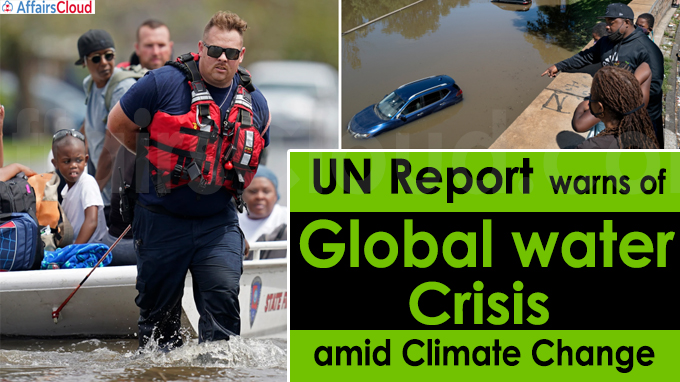 The World Meteorological Organization (WMO) warns that the number of people affected by water scarcity is expected to rise as climate change increases the global risk of water-related hazards like floods and droughts.
The World Meteorological Organization (WMO) warns that the number of people affected by water scarcity is expected to rise as climate change increases the global risk of water-related hazards like floods and droughts.
- According to the report ‘The State of Climate Services 2021: Water’, 3.6 billion people had inadequate access to water at least one month per year in 2018.
- The situation is expected to rise to more than five billion by 2050.
- Terrestrial water storage (TWS) dropped at a rate of 1 cm per year in 20 years (2002-2021).
- Note: TWS is the water available on the land surface and in the subsurface, including soil moisture, snow and ice.
- The biggest losses have occurred in Antarctica and Greenland.
- There is only 0.5 per cent of water on Earth which is usable and available freshwater.
Reasons
i.The increasing temperatures are resulting in global and regional precipitation change.
ii.Water resources across the world are under tremendous pressure due to human and naturally-induced stressors. These include population growth, urbanisation and decreasing availability of freshwater.
iii.Extreme weather events too have been responsible for the pressure on water resources realised across sectors and regions.
iv.All these conditions are leading to shifts in rainfall patterns and agricultural seasons, with a major impact on food security and human health and well-being.
World scenario
i.In the last 20 years, the frequency of water-related hazards has increased. ii.The flood-related disasters have risen by 134 per cent compared with the two previous decades since 2000.
iii.Asia has recorded the most flood-related deaths and economic losses.
iv.On the other hand, the number and duration of droughts also increased by 29 per cent over this same period.
v.Most drought-related deaths occurred in Africa.
Indian scenario
i.According to the WMO analysis, India is the topmost hotspot of TWS loss with the northern part of the country experiencing the maximum loss.
ii.India lost TWS at a rate of at least 3 cm per year. In some regions, the loss has been over 4 cm per year.
iii.If the loss of water storage in Antarctica and Greenland is excluded, India has recorded the highest loss in terrestrial water storage.
iv.Due to increasing population, the per capita water availability is reducing in India.
v.The average per capita water reduced to 1,545 cubic metres in 2011, from 1,816 cubic metres in 2001. And it is projected to further decrease to 1,367 cubic metres in 2031, according to the Union Ministry of Housing and Urban Affairs.
Rivers in India
i.According to the Falkenmark Water Stress Indicator, five of the 21 river basins in India are absolute water scarce with per capita water availability below 500 cubic metres.
ii.By 2050, six river basins will become absolute water scarce, six will become water scarce and four will become water stressed, according to the State of India’s Environment in figures, 2020.
About WMO
It stands for World Meteorological Organization
Secretary-General – Prof. Petteri Taalas
Headquarters – Geneva, Switzerland
Founded – 1950




